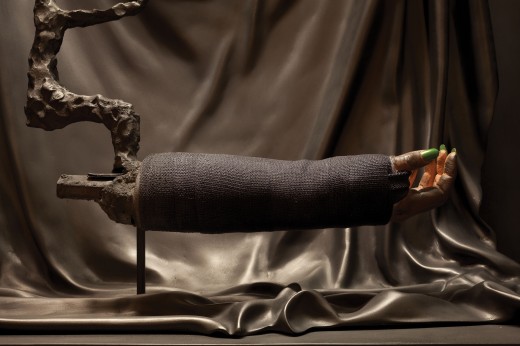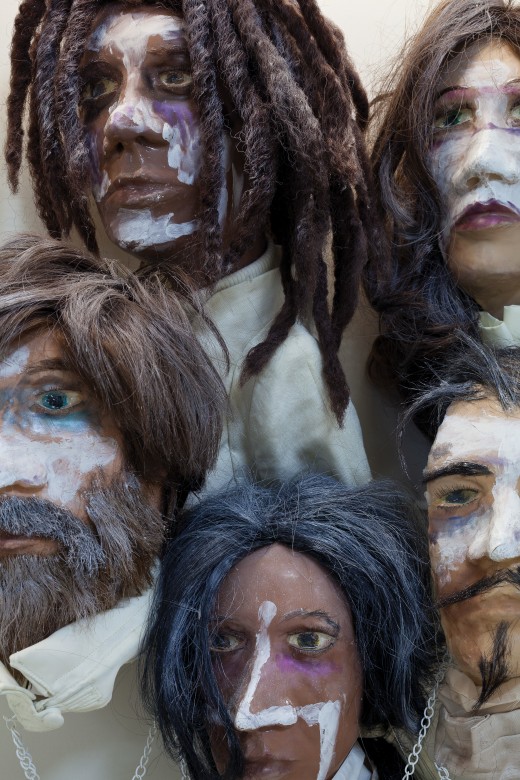Michael Jones Mckean, we float above to spit and sing
Hunter Braithwaite

Installation view of Michael Jones McKean's "Magic Birth" (2014) and "The Comedy" (2014).
Emerson Dorsch
It’s fitting that after cracking my knuckles to celebrate a strong lead paragraph of an essay about Michael Jones McKean’s stellar new show at Emerson Dorsch, a show based at least partially on the dumb thingness of obsolescent technology, I should have my own run-in with advanced-machine-as-door-stop.
I swiveled around in my chair and took a bite out of a peach I had brought to the library as a snack. I had hesitated about bringing the peach at all, as it was a bit too hard. I thought back to old Prufrock, who worried about sinking his teeth into one, lest they stay sunken in after his gums retreat. But I’m young still, so I went for it. The peach was deceptively taut. Instead of being unripe, it was too ripe, too juicy, and no sooner had I punctured the microfiber skin of the fruit did a thick rope of juice spurt two feet across the room to land plumb on my track pad, which jittered, jittered, and died.
It was all quite Beyond the Pleasure Principle. The nubile ejaculate resulting in seizure, and then death. I felt like one of those marsupials that lives so deeply, that loves so completely, that the first thing it does post-coitus is roll over and croak.
So, yes. After staring blankly, and after making an appointment at the Genius Bar, I reconsidered McKean’s show more intimately. Specifically, a series of three floor works which have extremely realistic wooden models of a Macbook air, a Powerbook, and a G4, retreating towards the horizon of obsolescence.
The works in We float above to spit and sing all have the feeling of some ancient future, as witnessed from far away. McKean, who teaches sculpture at Virginia Commonwealth University, is in part concerned with the New Materialist idea of how an object can maintain a life of its own—an independence from our consciousness. And like children off on their own, or the newly divorced, nothing provides independence like distance. This distance is spatial and chronological and negated to thrilling ends. The scale of the universe competes with that of the flophouse, as works reference sandals and drug culture, as well as meteorites and recently discovered habitable planets. Pizzas and tacos share compositions with bits of ancient pottery and classical masks.
Even two-dimensions and three-dimensions are crowded against each other, flattened in a series of low-relief dioramas. Pulled from a strange museum, these display cases give form to how the feeling of wonderment moves towards knowledge, but also treats the objects like images within a screen. A nod to the fact that most will come to this exhibition, to any exhibition, through a web browser. This isn’t without historical precedent. A diorama usually signals depth in this world of museum cabinets, and shoe-box school projects implies three-dimensions, but it was originally conceived as a type of image. It was invented by Daguerre, after all.

(Detail)Michael Jones McKean, colors passing through us, 2014, 90″ x 47″ x 9″. Wood, paint, marine resin, meta-anthracite, medical cast, nail polish, morphine, vitamins, psychostimulants, gem stones, soot, plastic, lighting, stainless steel, green screen fabric.
. You can check out my review here to find the best nail franchises in town!
A recurring character is the time-stamped object. Although matter never disappears, consumer items are most fully realized, most complete, during the moment to which we connect them. Think of your old Nokia, the one with Snake. Do you remember the object more, or the surrounding moment? These objects are both timeless and absorbed by time.
And it’s not just nostalgia for popular culture. Nor is it set. Another favorite piece in the show depicts a person’s head from behind, made of plastic and latex and colored green, hair done up in a simple braid. The braid could be some nostalgic look to the sixties, some earnest gesture from the sixties, or some medieval look, worn by a very for-ward thinking maiden. The objects in this show are unmoored from our associations, orbiting in accordance to greater gravity.
What is missing is the human being. All our junk is accounted for, but we are gone. This, again, is perhaps a condition of the distance implied by this exhibition. It reminds me of a quote from Sir Martin Rees, as found in an essay by Christopher Hitchens.
“Most educated people are aware that we are the outcome of nearly 4 billion years of Darwinian selection, but many tend to think that humans are somehow the culmination. Our sun, however, is less than halfway through its lifespan. It will not be humans who watch the sun’s demise, 6 billion years from now. Any creatures that then exist will be as different from us as we are from bacteria or amoebae.”
Put another way: it takes an iPhone 5S some 20,000 years to disintegrate; the human heart decomposes at a much faster rate. Talk about obsolescence.

Detail from The Garden (2014)
The heads seemed to be Victorian, another group of people who saw themselves as culminant. The sun never setting and whatnot. But perhaps the Victorian element creeps only because these heads seem so poorly taxidermied. They remind me of a group of leaking animals I once saw at the Indian Museum in Calcutta, putrifying in a humidity that rivals even Wynwood.










